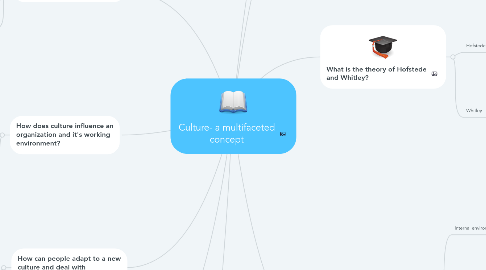
1. What are the levels of culture?
1.1. 1) Visible Level (artefacts)
1.1.1. Language
1.1.2. Architecture
1.1.3. Etiquette
1.2. 2) Beliefs and values
1.3. 3) Basic underlying assumptions
1.3.1. Beliefs + values become embedded
1.3.2. Difficult when two groups w/h different assumptions work together
2. How does culture influence an organization and it's working environment?
2.1. Handy's cultural types
2.1.1. Power culture
2.1.1.1. Influenced by dominant leader
2.1.2. Role culture
2.1.2.1. Influenced by clear, detailed job descriptions, what they are expected to do
2.1.3. Task culture
2.1.3.1. Work together to complete task
2.1.4. Person culture
2.1.4.1. Influenced by the individual wishes from people in an organization
2.2. Hierarchy plays a role in the view on culture
3. How can people adapt to a new culture and deal with differences?
3.1. Cultural Intelligence
3.1.1. Knowledge + fundamental principles
3.1.2. Mindfulness
3.1.2.1. Reflectiveness + creativity to cues
3.1.3. Flexibility
3.1.4. Combination
4. What is the "Porter's five forces model?"
4.1. A technique by identifying and listing those aspects of the five forces most relevant to the profitability of an organization at that time
4.1.1. Potential entrants
4.1.1.1. Threat of new entrants
4.1.2. Buyers
4.1.2.1. Bargaining power
4.1.3. Subsitutes
4.1.3.1. Threat of substitutes
4.1.4. Suppliers
4.1.4.1. Bargaining power
4.1.5. Industry competitors
4.1.5.1. Rivalry among existing firms
5. How are these theories and models (Porter, Hofstede, Whitley...) applicable?
5.1. There are advantages and disadvantages of all
5.1.1. A combination/integrating of all ensures the best result/profitability
5.2. Gives managers a broad overview
6. What is culture? (purpose)
6.1. Def: The ideas, customs and social behavior of a particular people or society
6.2. Purpose: Gives an identity that you can share with others to enrich them in return
7. Who shapes the culture?
7.1. Individual
7.2. Environment
8. What is the theory of Hofstede and Whitley?
8.1. Hofstede
8.1.1. 5 dimensions of culture
8.1.1.1. Power distance
8.1.1.1.1. Acceptance of a hierarchy/inequality
8.1.1.2. Uncertainty avoidance
8.1.1.2.1. threat of uncertainty
8.1.1.3. Individualism vs collectivism
8.1.1.4. Masculinity vs femininity
8.1.1.4.1. Masculinity: clearly distinct emotional gender roles
8.1.1.4.2. Femininity: overlapping emotional gender roles
8.1.1.5. Long-term and Short-term dimensions
8.1.1.5.1. Future oriented vs past/present oriented
8.2. Whitley
8.2.1. Different economic markets due to different industrialization patterns --> led to contrasting management systems
9. What are the different contexts in which an organization operates?
9.1. Internal environment
9.1.1. Managers most immediate context
9.1.1.1. people
9.1.1.2. culture
9.1.1.3. structure
9.1.1.4. technology
9.2. Competitive environment
9.2.1. Micro-environment: Industry specific
9.2.1.1. Suppliers
9.2.1.2. Customers
9.2.1.3. Potential entrants
9.2.1.4. Competitors
9.2.1.5. Substitutes
9.3. General environment
9.3.1. Macro-environment:
9.3.1.1. PESTEL
9.4. What is the PESTEL analysis?
9.4.1. Political factors
9.4.2. Economic factors
9.4.3. Socio-cultural factors
9.4.4. Technological factors
9.4.5. Environmental factors
9.4.6. Legal factors
9.4.7. Analyse all factors to ensure profitability
9.5. External environment
9.5.1. Elements beyond the organization
9.5.1.1. Combines
9.5.1.1.1. General environment
9.5.1.1.2. Competitive environment

